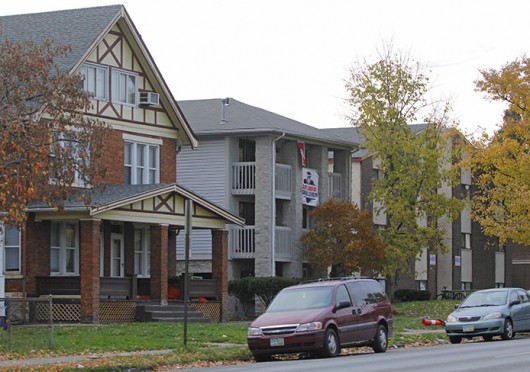
Most second-year students are no longer able to live off-campus with the new second-year living requirement now in effect. Credit: Ritika Shah | Buckeye TV news director
With the second-year living requirement now holding sophomores on campus, the lack of students out house hunting this leasing season has many landlords expressing concern: If second-year students are required to stay in the dorms, how will this affect the off-campus leasing market?
According to Ohio State’s 2016 Enrollment Report, 7,885 freshmen were enrolled on main campus, which translates to about 11.9 percent of the main campus population. As stated on the Second-year Transformational Experience Program website, an OSU study found that living on campus procured academic benefits. However, with the implementation of this living requirement, off-campus housing companies will lose business to the dorms.
Garth Denlinger, the property manager with local realtor Cooper Properties, said that even though it’s early, he’s beginning to notice subtle changes.
“This year, we don’t know how it’s going to shake out,” Denlinger said. “We’re doing OK, but we still have a lot of units to rent out.”
Though Todd Jessup, general manager of University Village Apartments, said rental season is starting off great for his apartments, he and his staff are also beginning to notice effects of the second-year living requirement.
“There’s no question that all of us have felt some changes,” he said. “You can’t remove that many people from the pool of candidates that lease apartments and not feel it in some way.”
Jessup said that because the number of renters is down, the market is shrinking, making it a race for companies to add new features to their properties to try to “wow” potential renters. By adding a “Resident’s Life Center,” which includes a 24-hour gym and reservable private conference rooms, Jessup said he sees the changing market as a challenge the company must rise above.
Although landlords and property managers will be losing potential renters, students who live on campus statistically do better academically, which was a key reason in implementing this requirement, said Dave Isaacs, spokesman for OSU’s Office Student Life. He also said that when OSU explored factors such as participation in on-campus events and interaction with peers as well as faculty, researchers found these were important predictors of second-year success.
“We also looked at studies who found that students that lived on campus participated in campus activities much more than those who didn’t, and that students who live on campus for two years have higher graduation and two-year retention rates than students who do not live on campus their first two years,” Isaacs said.
Jessup said he is on the fence on whether he believes this system will benefit students. He said he has seen the benefits of living on and off campus, but ultimately believes it’s based on the maturity level of the individual.
“I could see how it would be a benefit for certain personalities,” Jessup said. “Lack of choice is never really a good thing in just about anything you can think of. The more choices you have, the more ability you have to make your own, educated decision on where you would like to live.”
Denlinger is in charge of about 80 properties off campus. He said those with more off-campus properties might be able to afford some vacancies, but his company cannot, viewing the new requirement with a pessimistic outlook.
“It comes across as a complete sell-out,” Denlinger said. “I mean, how many billions of dollars does Ohio State need? And now they are taking out of our livelihood.”


